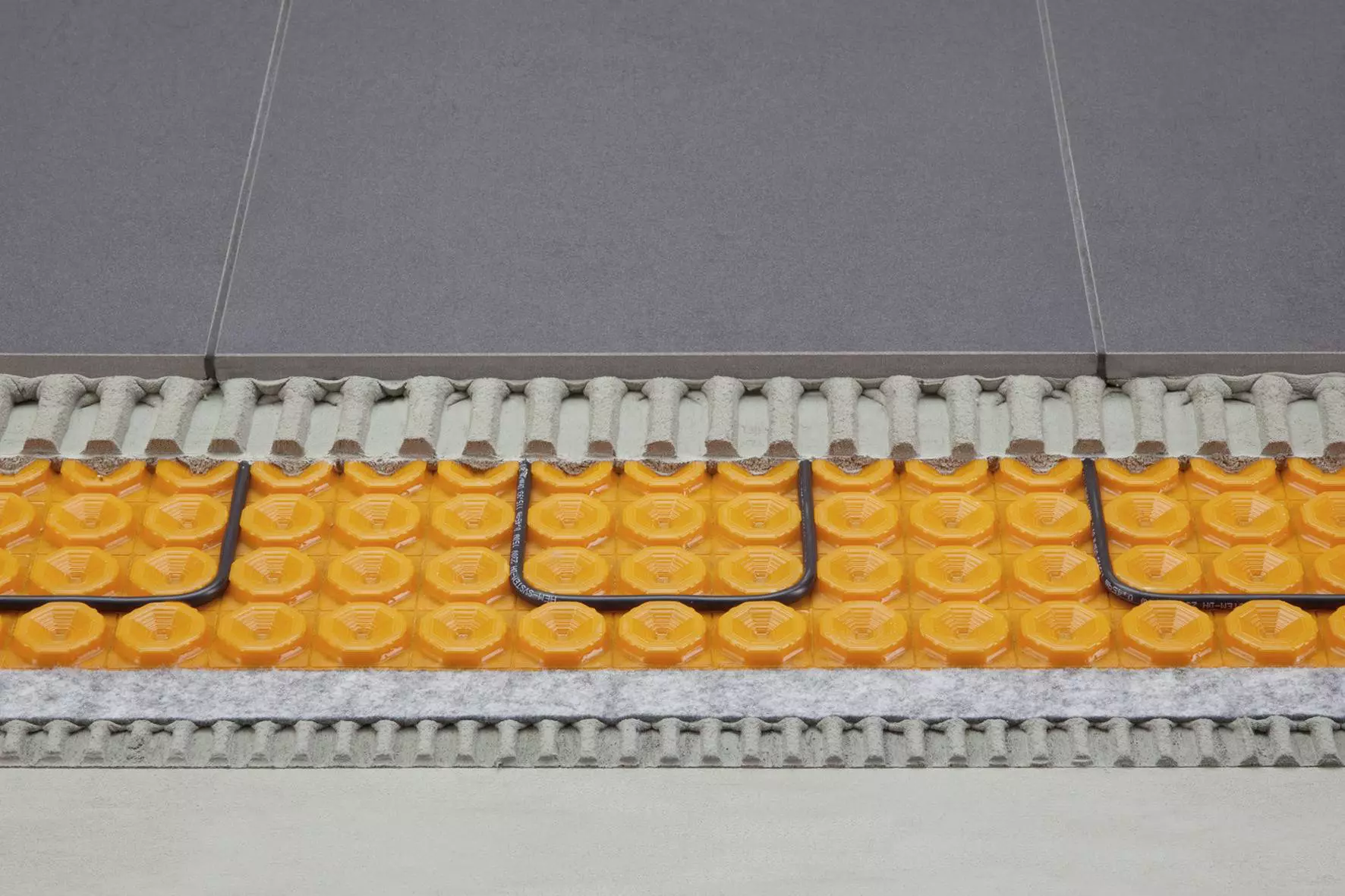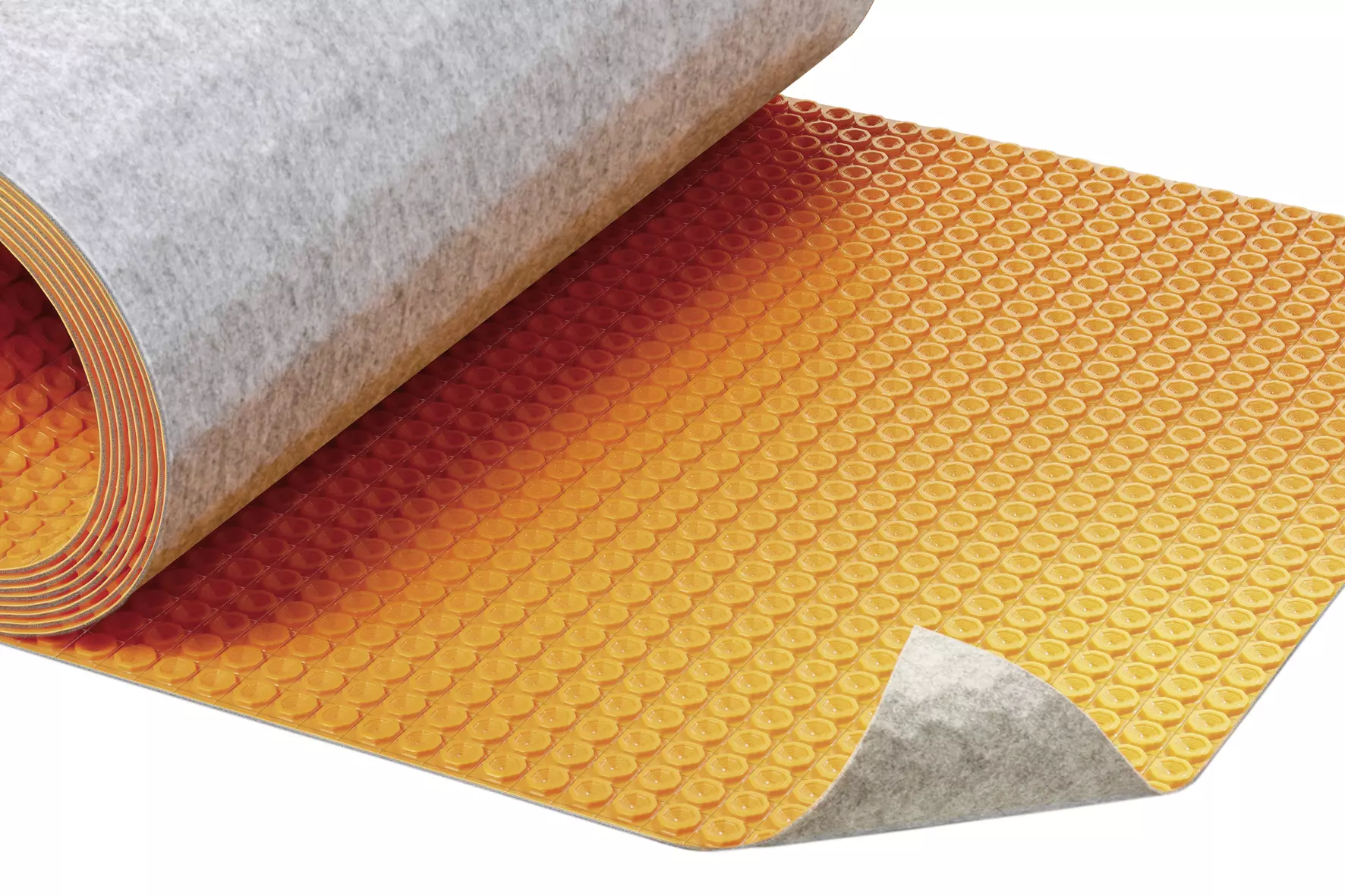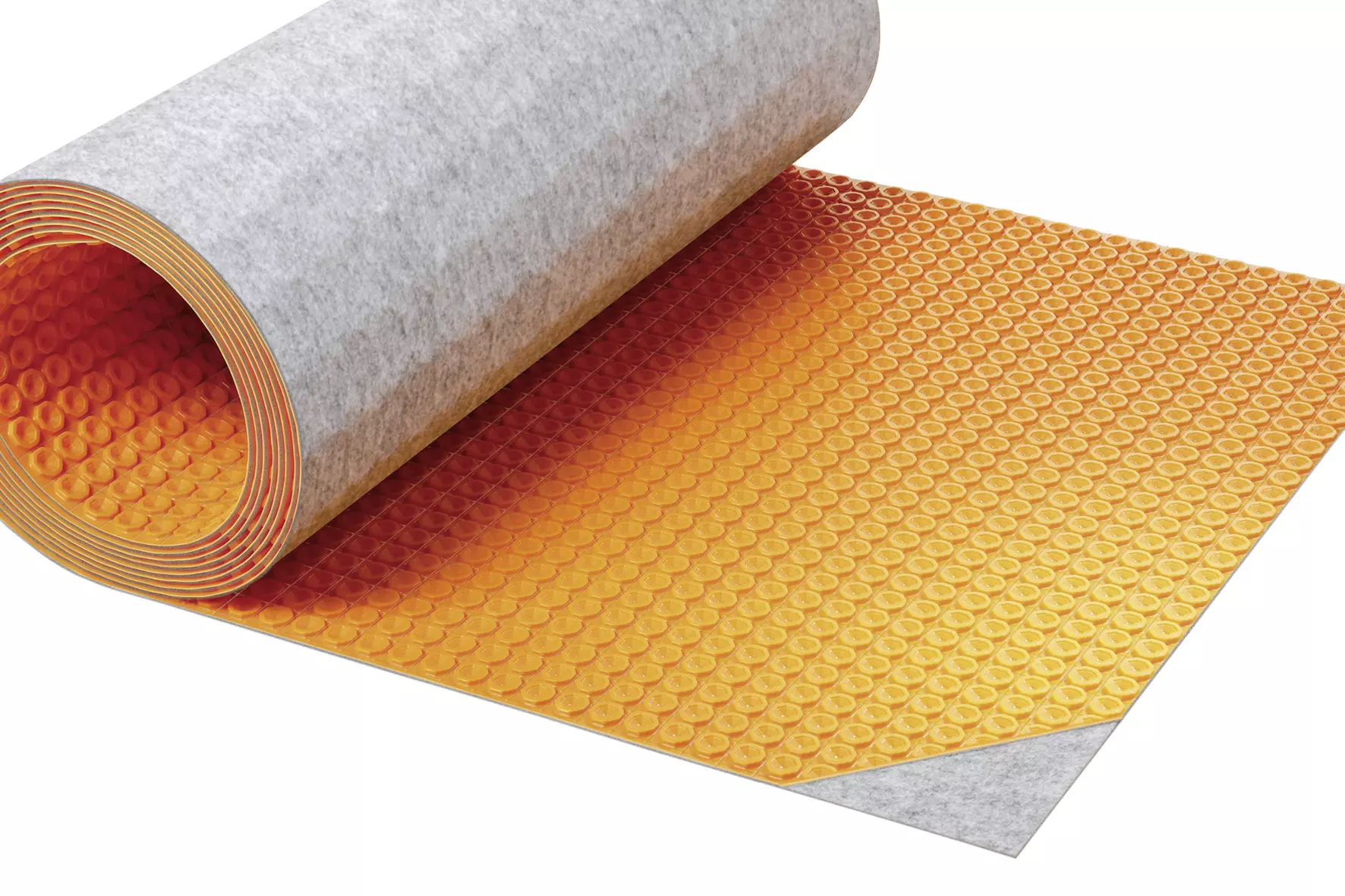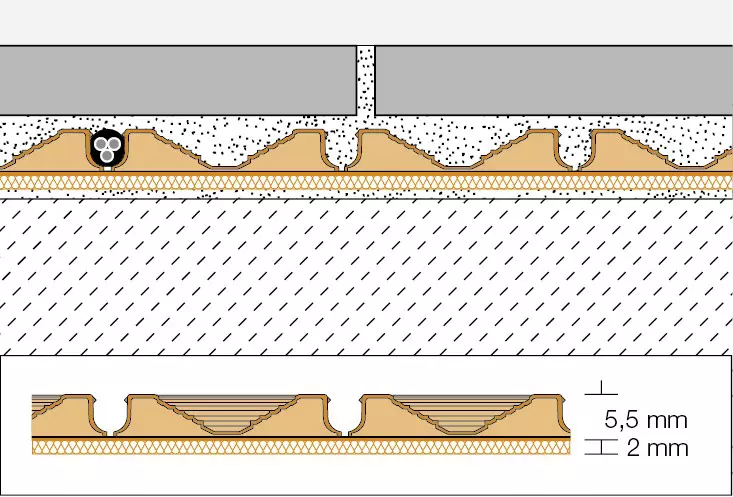Schlüter-DITRA-HEAT-DUO is a polypropylene membrane with a cut back stud structure and an anchoring fleece laminated on the underside.
It is a universal substrate for tile coverings that forms an uncoupling, waterproofing and vapour pressure equalisation layer and can also be used to attach heating cables.
DITRA-HEAT-DUO has a special 2 mm anchoring fleece laminated on the underside. In addition to bonding with the tile adhesive, the material reduces impact sound and ensures a quicker heat-up response.
The substrate for the installation of DITRA-HEAT-DUO must be level and load bearing. DITRA-HEAT-DUO is installed in thin-bed tile adhesive that is suitable for the substrate, using a notched trowel (recommended size: 6 x 6 mm). The anchoring fleece on the underside of DITRA-HEAT-DUO is fully embedded and the fabric bonds with the adhesive. The curing time of the adhesive must be observed.
In floor areas, the heating cables can be installed immediately after adhering DITRA-HEAT-DUO, using a minimum spacing of 9 cm (every third stud).
For wall installation, the heating cables are installed once an adequate adhesive bond has been reached. The installation spacing is either 6 cm (every 2nd stud) or 9 cm (every 3rd stud) (for more information, see data sheet 6.4 on page 7, see Downloads).
The use of mats is recommended for wall assemblies.
The tiles are installed directly over DITRA-HEAT-DUO in accordance with the applicable regulations, using the thin-bed method. The thin-bed tile adhesive bonds with the cutback stud structure of the DITRA-HEAT-DUO membrane.
DITRA-HEAT-DUO is waterproof and resistant to any chemical stresses that typically occur in conjunction with tiled coverings. Where required, DITRA-HEAT-DUO can be used to create a certified bonded waterproofing assembly.
Summary of functions:
a) Uncoupling
DITRA-HEAT-DUO uncouples the covering from the substrate and neutralises stresses between the substrate and the tile covering that result from various deformations. The material also bridge tension cracks from the substrate and prevent them from affecting the tile covering.
b) Waterproofing
DITRA-HEAT-DUO is a waterproof polypropylene membrane with a relatively high water vapour diffusion seal. With properly installed abutting joints and carefully sealed transitions to walls and structural elements, DITRA-HEAT-DUO can be used to create a certified bonded waterproofing assembly with the tile covering.
DITRA-HEAT-DUO can be installed in accordance with the waterproofing standard DIN 18534 applicable in Germany. Water exposure classes: W0-I to W3-I*. DITRA-HEAT-DUO also features the national technical approval (abP) required in Germany.
Moisture load class according to ZDB: 0 to B0, as well as A.
DITRA-HEAT-DUO has a European Technical Assessment (ETA) pursuant to ETAG 022 (watertight covering kits) and bears a CE mark.
System-certified tile adhesives must be used in areas that require CE-compliance or assemblies according to abP (certificate of technical approval). Please contact us at the address listed in this data sheet for further information about such tile adhesive products and the corresponding certificates of technical approval.
DITRA-HEAT-DUO effectively protects the sub-structure from damage caused by permeating moisture or aggressive substances.
* With abP and/or in compliance with ETA according to ETAG 022. Our Technical Department will be pleased to provide information on use and installation on request.
c) Load distribution (load induction)
DITRA-HEAT-DUO with its special 2 mm anchoring fleece laminated on the underside is suitable for traffic loads of up to 3 kN/m². This includes residential and light commercial use (private homes, office and administrative spaces, restaurants, hotels, conference rooms, nursing stations and patient rooms etc.).
The impact of hard objects must be avoided on ceramic coverings. The tile dimensions should be at least 5 x 5 cm.
d) Bonded assembly
Based on the fleece fabric bond in the thin-bed mortar on the substrate, and through mechanical anchoring of the thin-bed mortar in the undercut stud structure, DITRA-HEAT-DUO creates a strong bond between the tile assembly and the substrate. This makes DITRA-HEAT-DUO suitable for wall and floor installation.
e) Thermal separation
DITRA-HEAT-DUO has a special 2 mm anchoring fleece laminated on the underside. In addition to bonding with the tile adhesive, the material reduces impact sound and ensures a quicker heat-up response.
f) Sound insulation
An impact sound improvement value (ΔLW) of 13 dB was measured (according to DIN EN ISO 10140) in fully installed DITRA-HEAT-DUO assemblies.
The actual improvement offered by the respective assembly depends on the local conditions (structural design) and can deviate from this value. The measured test values therefore do not apply equally to every building situation.
Substrates for Schlüter-DITRA-HEAT-DUO
Always check that the substrates on which DITRA-HEAT-DUO is to be installed are level, load bearing, clean and compatible with the materials to be used. Remove all surface components that may weaken the bond. Any levelling, height adjustment or slope compensation must be carried out before installing DITRA-HEAT-DUO.
To guarantee effective floor heating, heat insulation is required, especially for installations adjoining soil or unheated spaces.
For a faster heat-up response on unheated screed assemblies, we recommend using DITRA-HEAT-DUO for its thermal separation function or Schlüter-KERDI-BOARD as an insulation layer (see data sheet 12.1).
Concrete
Concrete undergoes long-term structural deformation due to shrinkage. In addition, tension can build up in concrete and pre-stressed concrete due to deflection.
Since DITRA-HEAT-DUO absorbs the resulting stresses between the concrete and the tile covering, tiles can be immediately installed as soon as the concrete is ready to bear weight.
Cement screeds
In accordance with the applicable regulations, cement screeds must have cured for a minimum of 28 days prior to tile installation and have a moisture content below 2 CM %.
Floating and heated screeds have a particular tendency to buckle and crack even later, e.g. due to mechanical stresses and temperature fluctuations. With DITRA-HEAT-DUO, tiles can be installed on green cement screeds as soon as they are ready to bear weight.
DITRA-HEAT-DUO will neutralise cracks and screed deformations developing later and will prevent them from affecting the tile covering.
Gypsum based screeds
According to the applicable regulations, calcium sulphate screeds (anhydrite) may not have a residual moisture level of more than 0.5 CM % at the time of tile installation. In contrast, tile installation is permissible from a residual moisture level of 2 CM % with DITRA-HEAT-DUO.
If necessary, the screed surface must be treated (grinding, priming) as specified by the applicable technical regulations and manufacturer instructions. DITRA-HEAT-DUO can be installed with dry setting or other suitable thin-bed tile adhesives. DITRA-HEAT-DUO protects the screed surface against permeating moisture. Because gypsum based screeds are susceptible to moisture, screeds must be protected against humidity, e.g. moisture seepage on the underside.
Heated screeds
Note: Due to the thermal separation properties of the product, DITRA-HEAT-DUO should not be installed over heated screeds.
Vinyl coverings and coatings
All surfaces must be load bearing and pre-treated or suitable for bonding with an appropriate adhesive, in which the DITRA-HEAT-DUO anchoring fleece can be embedded. The compatibility of the adhesive with the substrate and with DITRA-HEAT-DUO must be verified in advance.
Chipboard and compressed wood panels
These materials undergo significant deformation based on the influence of moisture (or through fluctuations in humidity). Therefore, chipboard and compressed wood panels with special water-repellent treatment to protect against moisture must be used.
Such panels can generally be used as a floor and wall substrate in interior spaces. Refer to local regulations if these are acceptable.
However, they have to be thick enough to be sufficiently stable in conjunction with a suitable support assembly.
The structure should be fastened with closely spaced screws. All joints should either have a tongue and groove connection or covered with adhesive. Perimeter movement joints of about 10 mm have to be maintained at the transition to upright building structures.
DITRA-HEAT-DUO neutralises any tensions with the tile covering and also prevents permeating moisture.
Hardwood floors
In principle, ceramic coverings can be installed on sufficiently weight bearing hardwood floors with tongue and groove connections. The wooden substrate should have balanced moisture levels before DITRA-HEAT-DUO can be installed.
It has proven beneficial to install an additional layer of chipboard or compressed wood panels. Uneven floor surfaces should be levelled with suitable measures beforehand.
Masonry / mixed substrates
Masonry structures built with bricks, sand lime bricks, cement blocks, aerated concrete or similar materials are generally a suitable substrate for DITRA-HEAT-DUO. The substrate must be levelled in advance.
In restoration and remodeling projects, substrates frequently consist of different materials (mixed masonry), which have a tendency to crack at the interfaces with other materials due to different deformation rates. DITRA-HEAT-DUO protects the tile covering from the resulting stresses and cracks.
Gypsum plaster / bricks
Gypsum substrates should be completely dry in accordance with the relevant regulations. The surfaces may need to be pre-treated with a primer. DITRA-HEAT-DUO can be installed with dry-setting or other suitable thin-bed tile adhesives.





